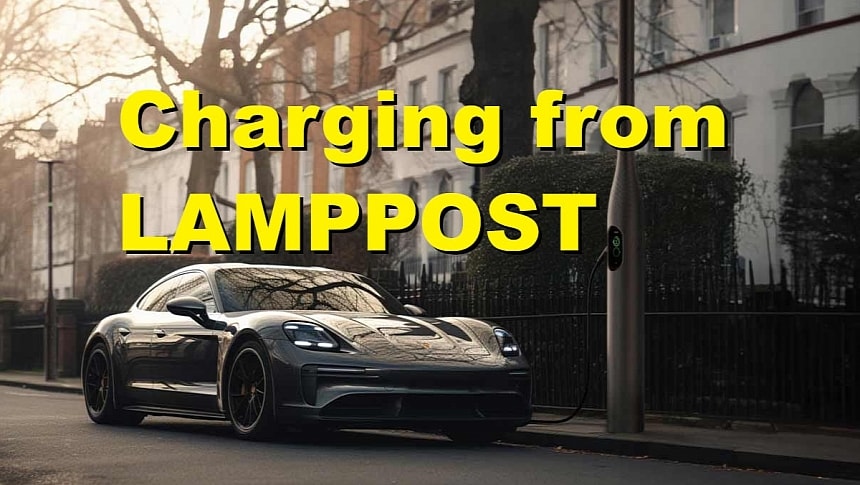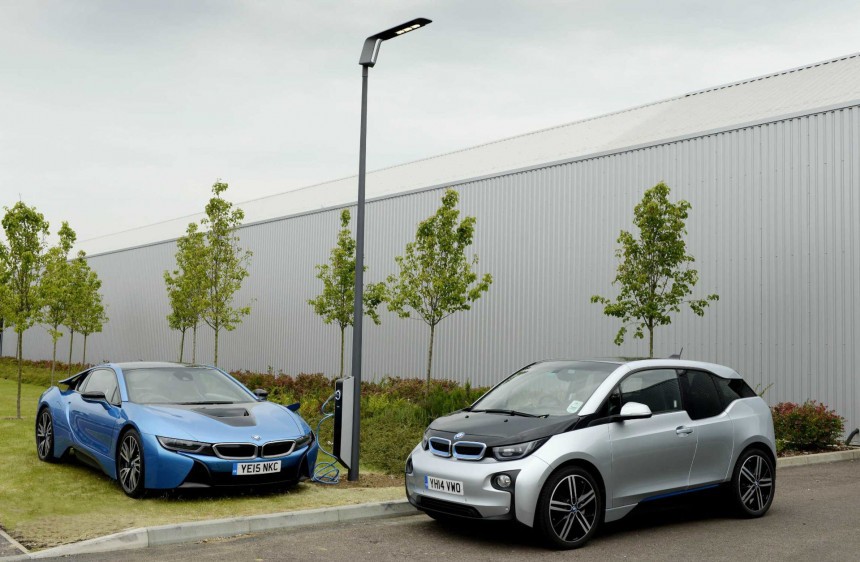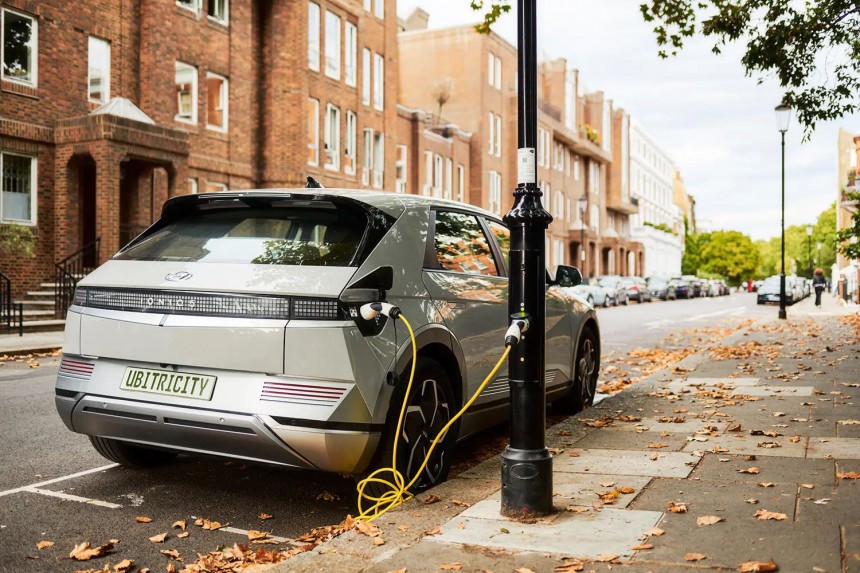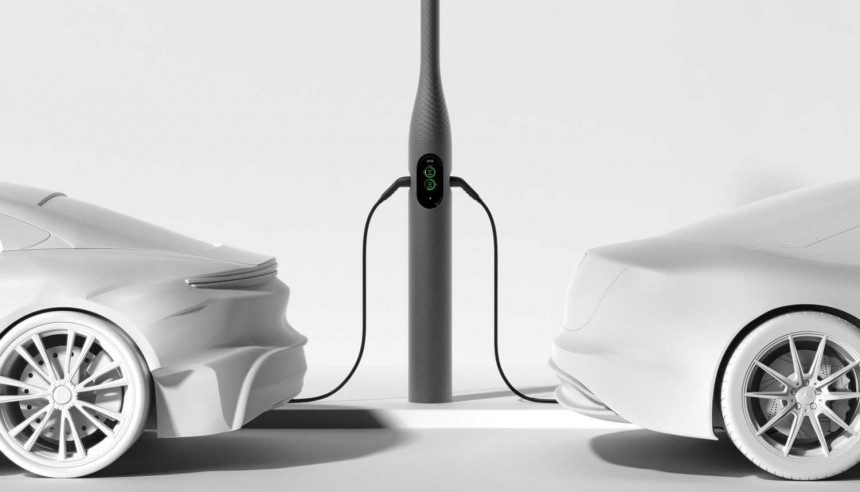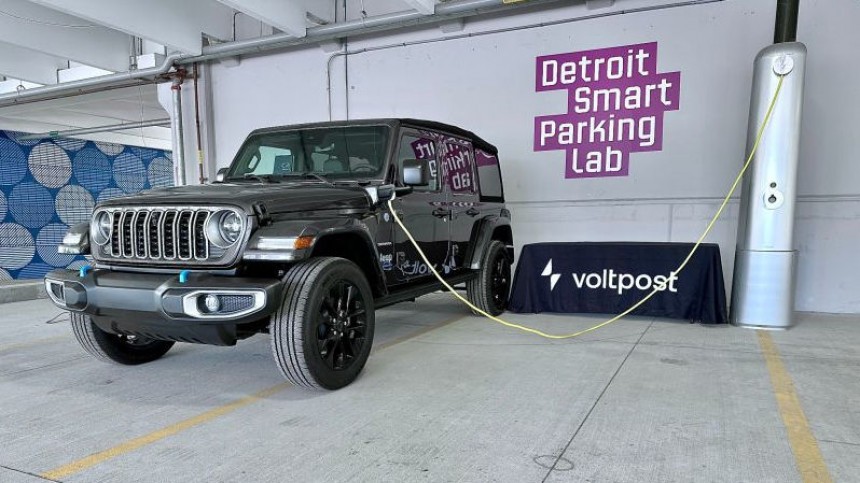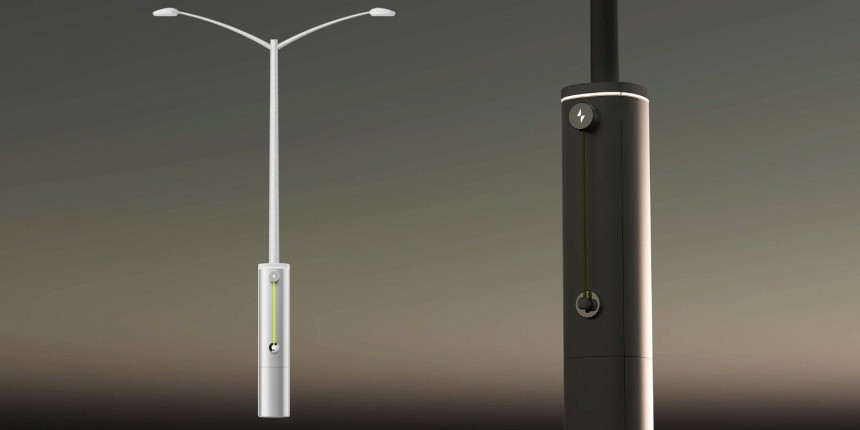While everybody complains these days that "EV sales cooled down," plug-in vehicle sales are far from the predicted doom. Millions of new EVs and plug-in hybrids are added to the global fleet every year, so the charging needs to grow quickly. This spring, Voltpost caught my attention thanks to an improved lamppost charging solution.
Let's get it straight: using a lighting pole to charge the battery of an electric or plug-in hybrid vehicle is not a new idea, nor a spectacular one. I first heard about such a charging solution a decade ago, when BMW Group showcased "a high-efficiency street lighting system that doubles as a charging station for electric vehicles" at its Mini Plant Oxford.
If I may, placing a wall charger on a lighting pole wasn't that original. Nevertheless, using an existing electrical infrastructure device to retrofit an EV charging device was a little genius. I mean, I never thought about it because I was so used to only seeing those poles for lightning purposes.
It really doesn't matter who invented this humble concept of street lighting; it's more important to note that its main purpose was to ensure the security of the city's inhabitants at night. Humanity had to wait some centuries until the 1700s when history credits Benjamin Franklin with discovering electricity.
One hundred years later, Paris was the first city in the world to install electric street light poles, and today, we're simply so used to it that we tend to ignore it. Of course, not observing one when you're busy browsing your smartphone while walking could end in a painfully hilarious impact YouTube is full of.
Ok, but how does it work? Where does the electricity powering the light bulbs come from? I know it sounds like a dumb question, and everybody knows that poles are connected to the electrical infrastructure underneath the pavement.
It's only that we don't care about it, so we tend to ignore the opportunities it can provide. Simply put, those electricity cables are already in place, but there's no need for lighting in the daytime. As a result, for half a day, those cables and those poles are useless.
Admit it, unless you're into urban infrastructure development, you never thought about it this way. Neither did I until I saw the Light & Charge concept BMW Group showcased during the second Low Carbon Oxford Week in 2015.
It wasn't an elegant solution, but it was practical enough. However, ubitricity, owned by the Shell Group, is the best-known company that has refined the concept by "hiding" the charging system inside the poles. Goodbye to bulky wall chargers and welcome tiny and almost invisible plugs.
Was this necessary? Maybe not, but you'll most likely upset any urban architect by ignoring the form factor. After all, these poles must integrate into the harmony of the urban landscape. Frankly, EV chargers usually scratch your eye because their design is not among the priorities.
From this perspective, I liked the British Alloy Design Studio's EVIE concept, which is basically a modern lighting pole containing two charging ports. Of course, you must be some kind of a "polehead" (I just made up this silly word…) to enjoy EVIE's design.
But for me, there's another detail of utmost importance: it has TWO charging points. Why should you care about that? It's all related to the lighting design guidance in urban areas. Apart from how these poles look, their height and the space between them depend on many other factors.
Did you know that the space between two lighting poles is roughly 2.5-3 times the height of the poles? Accordingly, two-meter (6.5-foot) high poles should be placed 5-6 meters (16-20 feet) apart. That's about the space of a regular parking spot in the street.
But get this: such short poles are used only in pedestrian areas. The average height of street poles is around 2.5-4.5 meters (9-14 feet), so the space between them is more than 6.5-7 meters (21-23 feet). Basically, you can't use all the poles to retrofit charging points because there's no correlation between the number of parking spots and lighting poles.
However, placing two charging points in one pole solves this dilemma. At any moment, all the cars parked on that street can use all the poles fitted with charging sockets. How's that for convenient charging your EV or plug-in hybrid?
But I think all of us tend to overlook an annoying detail: handling the charging cable is a pain in the ass. Get it out from the trunk or the frunk and unroll it (if it rains, then good luck with the mess…); plug one end into your car's socket and the other into the station's outlet; when the charging is done, do this steps the other way around.
It doesn't seem like much trouble, but trust me, few people are okay with doing this every day, even several times a day. That's why having a cable already attached to the station is mandatory to ease the charging process.
Voltpost has done this: it fitted its lamppost charger with two 6-meter (20-feet) retractable cables. Of course, these cables contain charging plugs that EV or plug-in hybrid users simply plug into their vehicles. But that's more to it.
Voltpost's solution was designed to be retrofitted on existing lighting poles in US cities like New York, Chicago, Detroit, and others. While the "first-of-a-kind lamppost EV charger" expression seems just a marketing exaggeration, the fact that it can be installed in less than two hours "without construction, trenching, or extensive permitting processes" is really remarkable.
Oh, and supposedly, this system can be upgraded to four charging points! Can you imagine the efficiency level such a charging pole can provide to cities? I can't wait to see others following this example.
Thanks to its efficiency, the "hybrid pole" is a good idea: you can use it both for lighting and for charging cars. Frankly, while many debates emphasize the need for DC fast charging, AC charging is more than enough for city dwellers. Level 2 charging, using powers up to 7 kW, is more than most people need.
That's because most of us use our cars 10-20% of the time, while the other 80-90% of the time, they are parked. Slow charging in that period offsets the daily commute usage in most cases. Also, let's be honest; it will take decades before we ditch our personal cars in cities in favor of alternative or public transport.
In my opinion, using lighting poles to charge cars' batteries is a necessary step toward a more complex wireless charging network. The latter will require very careful planning and take a long time to implement.
On the contrary, retrofitting existing poles or even replacing the old ones with more advanced ones is much less costly and can be done quickly, with little hassle. But, hey, it all makes sense only if we see the logic of it. If you wrongfully think that EVs are doomed, you wasted time reading this article.
If I may, placing a wall charger on a lighting pole wasn't that original. Nevertheless, using an existing electrical infrastructure device to retrofit an EV charging device was a little genius. I mean, I never thought about it because I was so used to only seeing those poles for lightning purposes.
The logic of the lighting pole
In fact, we tend not to observe these poles because they have been with us for a long time, since the ancient Greek and Roman civilizations. According to Wikipedia, around 500 BC, the Chinese were the first to create a kind of street lamp pole made from bamboo.It really doesn't matter who invented this humble concept of street lighting; it's more important to note that its main purpose was to ensure the security of the city's inhabitants at night. Humanity had to wait some centuries until the 1700s when history credits Benjamin Franklin with discovering electricity.
One hundred years later, Paris was the first city in the world to install electric street light poles, and today, we're simply so used to it that we tend to ignore it. Of course, not observing one when you're busy browsing your smartphone while walking could end in a painfully hilarious impact YouTube is full of.
Ok, but how does it work? Where does the electricity powering the light bulbs come from? I know it sounds like a dumb question, and everybody knows that poles are connected to the electrical infrastructure underneath the pavement.
It's only that we don't care about it, so we tend to ignore the opportunities it can provide. Simply put, those electricity cables are already in place, but there's no need for lighting in the daytime. As a result, for half a day, those cables and those poles are useless.
Hybrid pole: providing light AND charging your car
Long story short, as EV interest was growing and cities worldwide started to craft plans to curb emissions, companies offering solutions to charge EVs using lighting poles emerged. At first, their solutions were simply placing wall boxes on those poles and connecting them to the pole's cables.It wasn't an elegant solution, but it was practical enough. However, ubitricity, owned by the Shell Group, is the best-known company that has refined the concept by "hiding" the charging system inside the poles. Goodbye to bulky wall chargers and welcome tiny and almost invisible plugs.
From this perspective, I liked the British Alloy Design Studio's EVIE concept, which is basically a modern lighting pole containing two charging ports. Of course, you must be some kind of a "polehead" (I just made up this silly word…) to enjoy EVIE's design.
But for me, there's another detail of utmost importance: it has TWO charging points. Why should you care about that? It's all related to the lighting design guidance in urban areas. Apart from how these poles look, their height and the space between them depend on many other factors.
Did you know that the space between two lighting poles is roughly 2.5-3 times the height of the poles? Accordingly, two-meter (6.5-foot) high poles should be placed 5-6 meters (16-20 feet) apart. That's about the space of a regular parking spot in the street.
But get this: such short poles are used only in pedestrian areas. The average height of street poles is around 2.5-4.5 meters (9-14 feet), so the space between them is more than 6.5-7 meters (21-23 feet). Basically, you can't use all the poles to retrofit charging points because there's no correlation between the number of parking spots and lighting poles.
Even more convenient? Yes, we can
EV owners, carmakers, policymakers, and authorities all agree that we need more charging points. It's the "chicken or the egg" dilemma: many people don't buy EVs because the charging infrastructure is supposedly still scarce, while the companies and the governments don't install so many because there are not enough EVs on the streets for a solid business case.But I think all of us tend to overlook an annoying detail: handling the charging cable is a pain in the ass. Get it out from the trunk or the frunk and unroll it (if it rains, then good luck with the mess…); plug one end into your car's socket and the other into the station's outlet; when the charging is done, do this steps the other way around.
It doesn't seem like much trouble, but trust me, few people are okay with doing this every day, even several times a day. That's why having a cable already attached to the station is mandatory to ease the charging process.
Voltpost's solution was designed to be retrofitted on existing lighting poles in US cities like New York, Chicago, Detroit, and others. While the "first-of-a-kind lamppost EV charger" expression seems just a marketing exaggeration, the fact that it can be installed in less than two hours "without construction, trenching, or extensive permitting processes" is really remarkable.
Oh, and supposedly, this system can be upgraded to four charging points! Can you imagine the efficiency level such a charging pole can provide to cities? I can't wait to see others following this example.
The missing link to wireless charging
I know it's debatable whether using lighting poles as charging points is better than simply installing dedicated charging stations along parking lots. There are a lot of pros and cons, but prolonging that debate and not taking action is not helping anyone.Thanks to its efficiency, the "hybrid pole" is a good idea: you can use it both for lighting and for charging cars. Frankly, while many debates emphasize the need for DC fast charging, AC charging is more than enough for city dwellers. Level 2 charging, using powers up to 7 kW, is more than most people need.
That's because most of us use our cars 10-20% of the time, while the other 80-90% of the time, they are parked. Slow charging in that period offsets the daily commute usage in most cases. Also, let's be honest; it will take decades before we ditch our personal cars in cities in favor of alternative or public transport.
On the contrary, retrofitting existing poles or even replacing the old ones with more advanced ones is much less costly and can be done quickly, with little hassle. But, hey, it all makes sense only if we see the logic of it. If you wrongfully think that EVs are doomed, you wasted time reading this article.
